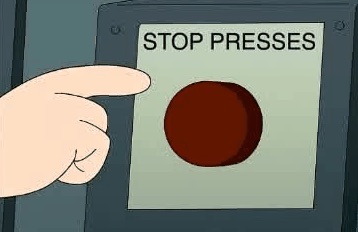Considering changing a manuscript at the last minute? Don’t!

Deadlines are a key feature of book production. At each deadline, making changes becomes more difficult. Let’s talk about why you should do everything possible to avoid making late changes.
A typical book production timeline might look like this:
Author’s manuscript to publisher: Jan 1
Copy editor’s comments to author: Jan 20
Author’s response to copy edits to publisher: Jan 25
Copy editor’s second round: Jan 31
Author’s second round response: Feb 2
Publisher sends PDF of laid out pages to author: Feb 23
Author’s comments on pages: Feb 28
Second draft pages PDF: Mar 5
Author’s second comments on pages: Mar 7
Final pages: Mar 8
Index created: Mar 11
Pages to printer: Mar 18
Printer proofs: Mar 23
Publisher approves printer proofs: Mar 25
Books in hand: May 1
Publication date: June 1
In theory, in this schedule, you can make changes on any date before March 25, the deadline shown here in bold. You might figure out a different, better way to write a sentence, identify a better example than what you wrote, delete a phrase that seems ill-considered, or sneak in a sidebar or graphic about a favorite topic. After all, if it’s not nailed down, it can change, right?
Wrong.
I have a unique perspective on this because before I was an author and ghostwriter, I was in charge of production at a publishing house. All people involved in book production have an instinct about this. We become more and more resistant to change the later in the process things get. The reason is that late changes that subvert the book production process have a high likelihood of messing up cost, quality, schedule, or all three.
Here are some reasons why late changes are a bad idea:
- Changes introduce more errors. Any coder will tell you that the most likely place a bug comes from is a fix intended to remedy an earlier bug. It’s the same thing here: you might inadvertently upset subject-verb agreement, repeat something you said in another part of the manuscript, or spell someone’s name wrong.
- Changes evade checks. If you make the change after the copy editor has reviewed the manuscript, they can’t check it. The same applies to other folks who’ve checked and approved the manuscript, like legal and technical reviewers.
- You put coauthors in a difficult position. If you have two or more authors, do they all have to approve every change? If they do, you’ll probably threaten the schedule.
- Changes aren’t fair to the people you’re writing about. You’ve sent text to those people at the fact verification stage. If you make changes after they’ve approved the text that talks about them, you can subvert the meaning of what they approved.
- Pagination changes could cause multiple problems. Changes that cause text to flow onto a new page can ripple through the rest of a chapter, in some cases causing widows, orphans, or ugly page breaks in a chapter that looked just fine before. Your change might demand repaginating the whole book from the point of the change, if it causes a chapter to overflow its last page. Either way, repagination messes up the index, which refers to specific page numbers. Even if the publisher jiggers the text layout to fix the pagination, that repagination effort can introduce other errors.
But what if something’s not right?
Despite these challenges, late changes are inevitable. When Facebook acquires Instagram while your book about social media is at the publisher, it might be worth it to sneak in a reference to that fact. The objective is not to eliminate late changes completely, but to reduce them to only a small number of minor problems that either slipped through or could not have been anticipated.
To do that, you need to hand in a “clean manuscript” — one that you truly believe is completely done, not mostly done.
And to do that, you need discipline in your writing process. Specifically:
- Get required approvals on chapter drafts as you complete the chapters. That means your focus while drafting should be on completing chapters, not smaller parts and pieces.
- Send the full manuscript to people who can blow it up (your boss, corporate CEOs, your mentor) with a firm deadline — and with enough time to get their feedback. Yes, this means your deadline for completing the manuscript should have a few weeks of flex in it.
- Get a friend who secretly believes they’re a copy editor to read it before you send it to the real copy editor. Catch and fix problems then. (Copy editors reading manuscripts full of errors are more likely to miss a few — they’re human, after all — so your challenge should be to try to avoid the grammatical and spelling errors before the copy editor even sees them.)
- Initiate fact verification three weeks before the manuscript deadline, and tell subjects you’ll need responses back in two weeks. Based on my experience, this means you’ll get about 90% of the fact verifications back by the manuscript deadline. You can fix the rest at the copy edit stage, but there won’t be many of those.
It’s all a matter of hygiene and taking deadlines seriously. Real authors respect publishing deadlines, because they’re intimately connected to quality. And quality makes a powerful impression.